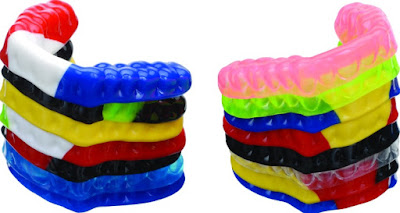The use of methamphetamines within the United States and the rest of North America is gradually increasing. The 2008 National Survey on Drug Use and Health reported that “12.6 million Americans aged 12 or older reported using methamphetamine at least once during their lifetimes.” Understandably, dental professionals are seeing more and more patients exhibiting signs of abuse of this potent drug. The attraction of meth has to do with the drug being inexpensive and relatively easy to produce, while giving a long period of being “high.” Meth can be ingested in a variety of ways; namely it can be “smoked, snorted, injected or taken orally.”
Methamphetamine is a stimulant of the central nervous system and highly addictive. Meth’s effects on the central nervous system are long lasting and destructive to systemic health. The drug stimulates the release and prevents the re-uptake of monoamines such as dopamine, norepinephrine and serotonin within the brain. These changes in the brain cause euphoric feelings.
Meth is also neurotoxic and can cause hemorrhaging, edema, hallucinations and feelings of paranoia. According to the ADA, in the short term, meth can cause “insomnia, hyperactivity, decreased appetite, increased respiration and tremors. Long psychological addiction, stroke, violent behavior, anxiety, confusion, paranoia, auditory hallucination, mood disturbances and delusions” are also seen in addicts.3 With extended period of methamphetamine abuse, the depletion of monoamines in the brain can cause learning dysfunctions. Rampant decay of tooth structure is a common consequence seen in the mouths of meth users. This condition is known as “meth mouth.”
In individuals with meth mouth, the pattern of decay tends to accumulate in the interproximal regions of the anterior teeth and the buccal and smooth surfaces of all teeth. Many patients exhibiting chronic meth mouth often have teeth that are reduced to nubs. This is thought to be caused by lack of oral hygiene, bruxism, poor eating choices and the effect of the drug on salivary production (xerostomia). In an articled published by the New York Times in 2005, Dr. John W. Shaner noticed that meth “causes dry mouth and that in turn allows decay to start, since saliva is unavailable to help control bacteria in the mouth. The drug also tends to leave users thirsty and craving a constant supply of soda pop and other sugary drinks, which spur the decay; Mountain Dew, he said, has become the preferred drink of methamphetamine users.
As aspiring dentists, many of us have seen individuals with caries-riddled mouths. How do we distinguish meth users from non-users? Signs include widespread decay in young adults exhibiting the decay characteristics noted in the above paragraph. Meth users also appear malnourished.
How do we treat meth mouth patients? Dr. Bob Brandjord, former ADA President, had the opportunity to speak to congressional staffers on Capitol Hill in 2006. During the briefing, Dr. Brandjord said, “Meth mouth robs people, especially young people, of their teeth, frequently leading to full mouth extractions and dentures.”2 Unfortunately, costly, extensive prosthodontic full-mouth reconstruction is often necessary to repair the damage caused by this drug. If patients cannot afford this treatment, dentures are the alternative treatment.
According to ADA.org, dentists should use the following protocol when treating patients with meth mouth:
Complete a comprehensive oral examination that includes taking a thorough dental and medical history.
-
If the patient is receptive to a medical consult, have the phone number of a local physician, clinic or substance abuse rehabilitation facility available and be familiar with their protocol, so that the patient can be told what to expect.10
Use preventive measures such as topical fluorides.
Encourage consumption of water rather than sugar-containing carbonated beverages.
Be cautious when administering local anesthetics, sedatives or general anesthesia, nitrous oxide, or prescribing narcotics.
Take opportunities to educate your patients about the risks associated with methamphetamine or any illicit drug use.3
In the 21st century, meth use is on the rise and shows no signs of slowing. The younger generation of dentists will definitely see meth mouth at some point during their career. When we do, we need to be prepared to educate and treat the problem appropriately.
Sources:
2) Palmer, Craig. “Meth Abuse Robs People of Their Teeth: Dr. Brandjord” Sept. 12, 2006. Accessed online on ada.org on Feb. 27, 2010.
3) Ada.org A-Z Topics: Meth Mouth. Accessed online on ada.org on Feb. 27, 2010.








